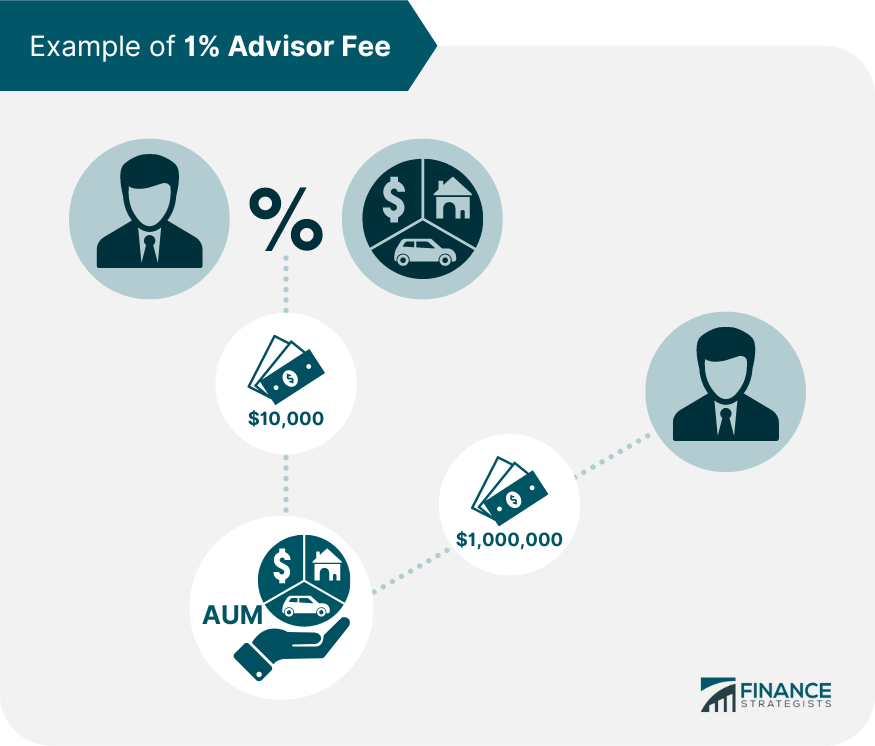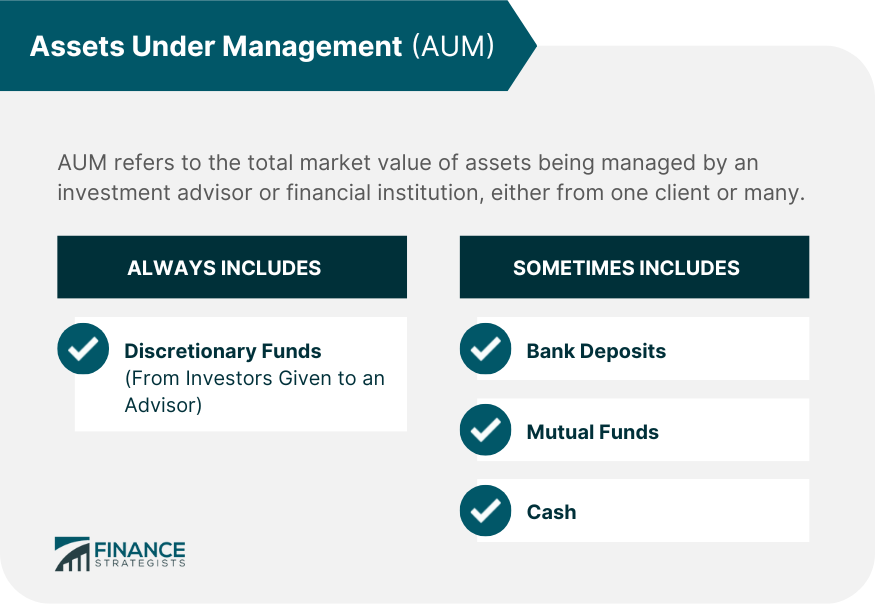The AUM acronym stands for "Assets Under Management." It refers to the total market value of assets being managed by an investment advisor or financial institution, either from one client or many. To define AUM precisely, the exact definition of AUM varies by institution; some include bank deposits, mutual funds, and cash in their computation, while others only consider the discretionary funds that investors have given an advisor to trade on their behalf. AUM fluctuates as the value of the assets managed changes with market performance. When evaluating a portfolio manager, assets under management (AUM) is one metric investors consider. Among other variables such as management performance, experience, disciplinary history, and other offered services, a greater AUM can be an indicator of a manager who has demonstrated proficiency. Investment advisors that oversee more than $25 million in AUM must register with the Securities and Exchange Commission (SEC). Advisors overseeing less may register with state securities administrators. Managers may charge a percentage of the total AUM they manage for a client for their services, such as 1%. Research the required minimum of investable assets, services offered, fees, disciplinary history, and experience thoroughly prior to selecting a wealth management firm. At present, the financial institution with the most assets under management is BlackRock, with over $6.8 trillion in assets. In second is Vanguard Group with just over $6 trillion, followed by UBS Group with $3.26 trillion, Fidelity with $3.2 trillion, and State Street Global Advisors with $3.12 trillion. NAV, or Net Asset Value, is the total value of assets minus all its liabilities of a fund, such as a mutual fund or ETF, often shown on a per-share basis. NAV shows what price shares in a fund can be bought and sold at. AUM by contrast refers to the value of assets managed by an individual or firm, not a fund. Unlike NAV, AUM is in reference to the total value of assets being managed rather than expressed on a per-share basis. One of the metrics for determining the quality of an ETF, or Exchange Traded Fund, is AUM, or Assets Under Management. The more assets that are contained in an ETF, as well as the higher the volume of trading that occurs, the less likely shares of the fund are to swing in price. This makes these types of funds safe and stable investments. Under management refers to something belonging to a client that is being managed by another party on their behalf. In the finances industry, this typically refers to assets under management, or the assets that a wealth manager, investment advisor, or mutual fund manager is employing on behalf of their clients. The calculation used by a company to determine its total Assets Under Management is not always consistent between companies. Many only count discretionary funds given by investors, but others may include capital owned by executives. Additionally, AUMs calculation will fluctuate depending on market performance since the assets being managed are typically put into the markets. Financial institutions often release their AUM totals quarterly or annually. Assets Under Management may also fluctuate based on the performance of investments. AUM is an acronym that stands for Assets Under Management. Assets Under management (AUM) is defined as the total amount of assets under the oversight of a particular asset management company, such as a mutual fund. Some institutions only count discretionary funds, meaning funds that investors give for investment purposes, while other institutions also count bank deposits and more.What Does AUM Stand For?
What Is AUM in Finance?

AUM Payment and Fees

Largest Institutions by AUM
AUM vs NAV
AUM for ETFs
"Under Management" Meaning
Assets Under Management Calculation

AUM Definition Summary
Assets Under Management (AUM) FAQs
The AUM acronym stands for Assets Under Management. It refers to the total market value of assets being managed by an investment advisor or financial institution, either from one client or many.
Managers may charge a percentage of the total AUM they manage for a client, usually around 1 percent. Research the required minimum of investable assets, services offered, fees, disciplinary history, and experience thoroughly prior to selecting a wealth management firm.
At present, the financial institution with the most assets under management is BlackRock, with over $6.8 trillion in assets. In second is Vanguard Group with just over $6 trillion, followed by UBS Group with $3.26 trillion, Fidelity with $3.2 trillion, and State Street Global Advisors with $3.12 trillion.
NAV, or Net Asset Value, is the total value of assets minus all its liabilities of a fund, such as a mutual fund or ETF, often shown on a per-share basis. NAV shows what price shares in a fund can be bought and sold at. AUM by contrast refers to the value of assets managed by an individual or firm, not a fund. Unlike NAV, AUM refers to the total value of assets being managed rather than expressed on a per-share basis.
The calculation used by a company to determine its total Assets Under Management is not always consistent between companies. Some only count discretionary funds, meaning those that investors give for investment purposes, while other institutions also count bank deposits and more.
True Tamplin is a published author, public speaker, CEO of UpDigital, and founder of Finance Strategists.
True is a Certified Educator in Personal Finance (CEPF®), author of The Handy Financial Ratios Guide, a member of the Society for Advancing Business Editing and Writing, contributes to his financial education site, Finance Strategists, and has spoken to various financial communities such as the CFA Institute, as well as university students like his Alma mater, Biola University, where he received a bachelor of science in business and data analytics.
To learn more about True, visit his personal website or view his author profiles on Amazon, Nasdaq and Forbes.















